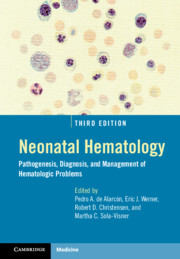Book contents
- Neonatal Hematology
- Neonatal Hematology
- Copyright page
- Contents
- Foreword
- Preface
- Contributors
- Section I Developmental Hematology
- Section II Bone Marrow Failure and Immune Disorders
- Section III Erythrocyte Disorders
- Chapter 6 Newborn Genetic Screening for Blood Disorders
- Chapter 7 A Guide to Identifying the Cause of Anemia in a Neonate
- Chapter 8 Anemia of Prematurity and Indications for Erythropoietin Therapy
- Chapter 9 Hemolytic Disease of the Fetus and Newborn
- Chapter 10 Neonatal Hemolysis
- Chapter 11 Polycythemia and Hyperviscosity in the Newborn
- Section IV Platelet Disorders
- Section V Leucocyte Disorders
- Section VI Hemostatic Disorders
- Section VII Neonatal Transfusion Medicine
- Section VIII Neonatal Oncology
- Section IX Miscellaneous
- Index
- Plate Section (PDF Only)
- References
Chapter 6 - Newborn Genetic Screening for Blood Disorders
from Section III - Erythrocyte Disorders
Published online by Cambridge University Press: 30 January 2021
- Neonatal Hematology
- Neonatal Hematology
- Copyright page
- Contents
- Foreword
- Preface
- Contributors
- Section I Developmental Hematology
- Section II Bone Marrow Failure and Immune Disorders
- Section III Erythrocyte Disorders
- Chapter 6 Newborn Genetic Screening for Blood Disorders
- Chapter 7 A Guide to Identifying the Cause of Anemia in a Neonate
- Chapter 8 Anemia of Prematurity and Indications for Erythropoietin Therapy
- Chapter 9 Hemolytic Disease of the Fetus and Newborn
- Chapter 10 Neonatal Hemolysis
- Chapter 11 Polycythemia and Hyperviscosity in the Newborn
- Section IV Platelet Disorders
- Section V Leucocyte Disorders
- Section VI Hemostatic Disorders
- Section VII Neonatal Transfusion Medicine
- Section VIII Neonatal Oncology
- Section IX Miscellaneous
- Index
- Plate Section (PDF Only)
- References
Summary
The newborn screening (NBS) program is a well-established comprehensive public health initiative with the main goal of identifying newborns affected by genetic disorders, for whom early interventions may prevent disease morbidity and mortality. The early-in-life screening for genetic conditions not only permits early institution of specific therapeutic measures for those affected, but also creates the opportunity for genetic counselling for carriers (e.g., parents). Several hematologic conditions have benefited from NBS, most notably hemoglobinopathies, particularly sickle cell disease (SCD), for which early diagnosis with preemptive penicillin initiation has substantively reduced pediatric mortality [1, 2].
- Type
- Chapter
- Information
- Neonatal HematologyPathogenesis, Diagnosis, and Management of Hematologic Problems, pp. 93 - 112Publisher: Cambridge University PressPrint publication year: 2021



